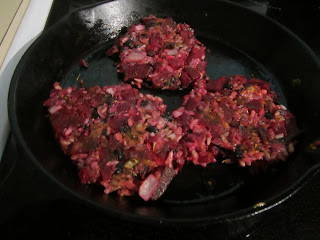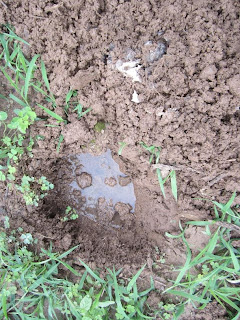This year we have somewhere in the vicinity of 70 tomato plants. Some were planted from seeds, some were given to us, and others were volunteers. Well, what a jungle the tomato patch has turned into! We have a few trellises that we made a few years ago with electrical conduit and trellis netting (costs about $15 to make); but to minimize resources, save money, and keep things local, we made some with logs from the woods, some extra fence posts, and miscellaneous pieces of balling twine and rope. Jon and I are still trying to find the best rope or trellis netting to use in the garden. Some materials fall apart whereas others are coated with plastic. What is your preferred trellis material?
Homemade Tomato Trellis and Tomato Hornworms
Beet Burgers
As mentioned in a previous post, we had really good success with the beets grown in cow manure. The beets that happened to grow outside the cow manure pile grew slower and did not have nearly the sweet delicious taste that the other beets had. A good way to use the bland-tasting beets is to make them into beet burgers! This recipe may sound strange but these burgers are really good and full of flavor. Here's the recipe accompanied with some pictures:
salt & pepper
~4 T flour
cheese (optional)
Combine the first 9 ingredients in a medium bowl. Sautee the onion and garlic in olive oil and the add them to the remaining ingredients. Form mixture into patties, adding flour if needed to hold everything together. If the patties fall apart in the skillet, use the flipper to mold the patty; press down on the patty before flipping. Wait several minutes before flipping the burger and only flip it ONCE. If you flip it multiple times, it will probably fall apart. Add cheese for melting if you want.
Labels: Recipes
The Garden is Swimming
What a wet couple of weeks we've had! Since June 26th we've received ~9 inches of rain. It really spread itself out, 9 out of the last 16 days we had a quarter of an inch or more. With all of this rain, some plants (e.g. potatoes) have struggled whereas others (e.g. corn) have been thriving.
Labels: Garden
Foraging for Wild Chanterelle Mushrooms!
- 1 cup chicken broth
- 1/2 pound chanterelles, minced
- 1/2 cup (1 stick ) butter
- 1/2 teaspoon salt
- 1 cup unbleached all-purpose flour
- 3 eggs
Labels: Mushrooms





























